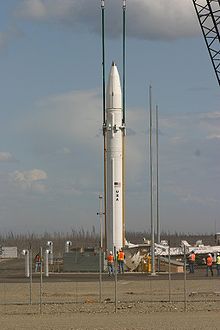
Back Ground-Based Midcourse Defense Spanish Maalle sijoitettu reittivaiheen ohjuspuolustus Finnish Ground-Based Midcourse Defense French Ground-Based Midcourse Defense ID GBI (ミサイル) Japanese 지상 기반 외기권 방어 Korean Ground-Based Midcourse Defense Polish Ground-Based Midcourse Defense Portuguese Ground-based Midcourse Defense Russian Ground-Based Midcourse Defense Ukrainian

Ground-Based Midcourse Defense (GMD), previously National Missile Defense (NMD), is an anti-ballistic missile system implemented by the United States of America for defense against ballistic missiles, during the midcourse phase of ballistic trajectory flight. It is a major component of the American missile defense strategy to counter ballistic missiles, including intercontinental ballistic missiles (ICBMs) carrying nuclear, chemical, biological or conventional warheads.[1]
As of 2018, the system is composed of two interceptor staging bases in the states of Alaska and California, with 40 staged in the former, 4 staged in the latter, for a total of 44 interceptors, as well as the component early warning and targeting sensors based on land, sea, and in orbit.[2][3] As of 2019, a Missile Defense Review has requested 20 additional interceptors to be based in Fort Greely, Alaska, though their delivery has not materialized.[4]
GMD is administered by the U.S. Missile Defense Agency (MDA), while operational control is provided by the U.S. Army, with support functions provided by the U.S. Air Force and U.S. Space Force.
- ^ "MDA - The Ballistic Missile Defense System". www.mda.mil. Retrieved 14 April 2024.
- ^ "There is no guaranteed defence against ballistic missiles—yet". The Economist. Retrieved 28 January 2018.
- ^ "Ground-based Midcourse Defense (GMD) System". Missile Threat.
- ^ "President Trump's Plans to Boost Missile Defense Could Spark Arms Race". Time. 17 January 2019. Retrieved 18 January 2019.
© MMXXIII Rich X Search. We shall prevail. All rights reserved. Rich X Search